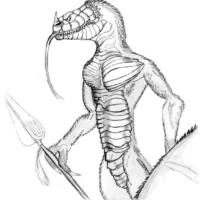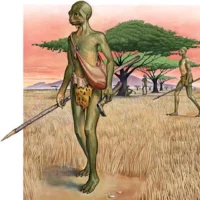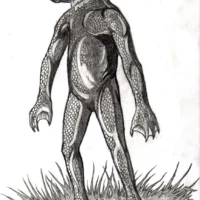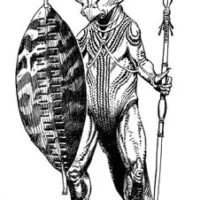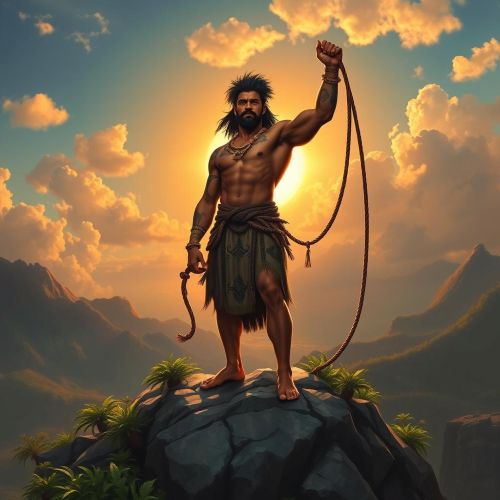Intulo : The Wise Lizard
Listen
At a glance
| Description | |
|---|---|
| Origin | Zulu Mythology |
| Classification | Animals |
| Family Members | N/A |
| Region | South Africa |
| Associated With | Knowledge |
Intulo
Introduction
Intulo, a legendary cryptid, has been an integral part of Xhosa and Zulu folklore for thousands of years. Originating from the South African province of KwaZulu-Natal, tales of the Intulo have captivated the imagination of many despite the absence of concrete evidence of its existence. In the rich tapestry of Zulu mythology, the Intulo stands out as a particularly intriguing figure. Often described as a lizard-man, the Intulo bridges the gap between the natural and supernatural worlds, combining the physical traits of a reptile with the mystique of a mythical being.
This creature, with its lizard-like appearance and humanoid features, plays a significant role in Zulu mythology by embodying the concept of mortality and the impermanence of life on Earth. Its unique blend of characteristics and its role in explaining profound life concepts highlight the Intulo’s importance in the cultural narratives of the Zulu people.
Physical Traits
Descriptions of Intulo vary, yet it is consistently portrayed as a reptilian creature. Some narratives depict it as a swift lizard, while others highlight its humanoid traits. References to a blue-headed gecko suggest a specific species, but the overall image remains open to interpretation.
The humanoid features add a layer of complexity to the Intulo’s depiction. Questions arise about its posture—does it stand upright like a human or maintain a reptilian stance? Additionally, its facial characteristics are ambiguous, potentially blending human and animalistic elements. These uncertainties allow for diverse artistic representations, each contributing a unique perspective to the legend.
While detailed descriptions are sparse, Intulo is widely believed to be a lizard-like creature with human characteristics. Contemporary accounts typically describe it as a bipedal reptilian being with a humanoid appearance. It is said to have a scaly body, sharp claws, and a long tail. Some stories suggest a distinctive frill around its neck, similar to that of a frilled lizard.
The Intulo’s combination of human and reptilian features gives it a fearsome and otherworldly appearance. Often depicted with sharp claws and piercing eyes, it possesses a long, tapering tail and a lizard-like head. Its tough, resilient scales provide natural armor, underscoring its formidable nature and its role as a creature that straddles both the human and reptilian realms.
Family
Zulu mythology emphasizes lineage, even for mythical creatures. While Intulo’s immediate family remains unclear, it’s linked to the creator deity, the Great One. Acting as the Great One’s messenger, Intulo delivers a pivotal message to humanity. This connection suggests a position of importance within the pantheon. Some versions hint at a reptilian ancestry, imbuing Intulo with a sense of power. Intulo might even be part of a larger community of similar beings, each contributing to the balance between the natural and supernatural realms.
Other names
Intulo is primarily recognized by this name in Zulu and Xhosa folklore. However, across different regions and cultures within Southern Africa, the creature is also known by several other names. These alternative names often correspond with different characteristics or roles attributed to the creature, reflecting the diverse ways it is perceived and integrated into local folklore.
Despite the variations in naming and attributes, the essence of the Intulo as a lizard-like being remains consistent across these tales. Although Intulo does not have widely recognized alternative names within Zulu mythology, its association with lizards and geckos might lead to it being referred to by vernacular terms for these reptiles in the Zulu language. This highlights the adaptability and multifaceted nature of the creature’s identity within the cultural context.
Powers and Abilities
In Zulu mythology, Intulo is tasked by the Great One, the creator deity, with delivering a profound message to humanity. This message, echoing through the ages, highlights the transient nature of life, emphasizing that all living beings—humans, animals, and plants—will eventually meet their end, leaving nothing eternal on Earth. Rooted in African culture, this message remains profoundly relevant in contemporary society, serving as a reminder of the impermanence of existence.
Intulo’s significance in the myth lies not in conventional supernatural abilities but in its swiftness, a trait crucial to its role as a messenger. In the creation narrative, Intulo’s speed determines the course of human destiny. While it lacks overt powers, Intulo’s influence is profound, as it brings awareness of mortality, fundamentally reshaping human understanding and altering the trajectory of existence.
At the heart of Intulo’s tale is the contrast between mortality and immortality, embodied by Intulo and its counterpart, Unwaba. Intulo, the swift lizard, arrives first, delivering the sobering truth of death to humanity. In contrast, Unwaba, the slow chameleon, carries the message of immortality. However, upon learning of Intulo’s proclamation, Unwaba chooses silence, fearing to contradict the Great One. This decision leads to a world where death reigns supreme, a consequence directly attributed to Intulo’s swift delivery of its message.
Despite its role as the harbinger of death, Intulo is not portrayed as malevolent. Rather, it fulfills its duty as a messenger, embodying the weight of the message it carries. The enduring significance of Intulo’s narrative lies in the juxtaposition between the promise of eternal life and the stark reality of mortality, a theme that resonates deeply within Zulu mythology and continues to captivate audiences across generations.
Modern Day Influence
Intulo remains a pivotal figure in African folklore, deeply ingrained in the cultural fabric of the region. Passed down through generations, the legend of Intulo continues to hold significant cultural relevance, enduring as a cherished part of African heritage. Despite the absence of empirical evidence, the belief in Intulo’s existence persists among many, hinting at the creature’s elusive allure and potential yet to be unveiled by science.
Beyond its status as a mythical being, Intulo symbolizes the importance of environmental stewardship and respect for nature. Said to inhabit grasslands and rainforests, Intulo serves as a poignant reminder of the necessity to conserve these natural habitats, safeguarding biodiversity and ecological balance. Its legacy extends beyond folklore, resonating in modern interpretations that explore themes of life’s transience and the interconnectedness of humanity with the natural world.
Intulo’s story offers valuable lessons on the importance of clear communication, serving as a cautionary tale about the consequences of misinterpretation or withheld information, exemplified by Unwaba’s silence in the myth. Moreover, in contemporary contexts, Intulo symbolizes acceptance, confronting the inevitability of death with grace and resilience. By acknowledging Intulo’s role, individuals are encouraged to embrace life fully and cherish the fleeting moments of existence.
Related Images
Frequently Asked Questions
What is lorem Ipsum?
I am text block. Click edit button to change this text. Lorem ipsum dolor sit amet, consectetur adipiscing elit. Ut elit tellus, luctus nec ullamcorper mattis, pulvinar dapibus leo.
What is lorem Ipsum?
I am text block. Click edit button to change this text. Lorem ipsum dolor sit amet, consectetur adipiscing elit. Ut elit tellus, luctus nec ullamcorper mattis, pulvinar dapibus leo.
What is lorem Ipsum?
I am text block. Click edit button to change this text. Lorem ipsum dolor sit amet, consectetur adipiscing elit. Ut elit tellus, luctus nec ullamcorper mattis, pulvinar dapibus leo.
What is lorem Ipsum?
I am text block. Click edit button to change this text. Lorem ipsum dolor sit amet, consectetur adipiscing elit. Ut elit tellus, luctus nec ullamcorper mattis, pulvinar dapibus leo.
What is lorem Ipsum?
I am text block. Click edit button to change this text. Lorem ipsum dolor sit amet, consectetur adipiscing elit. Ut elit tellus, luctus nec ullamcorper mattis, pulvinar dapibus leo.


